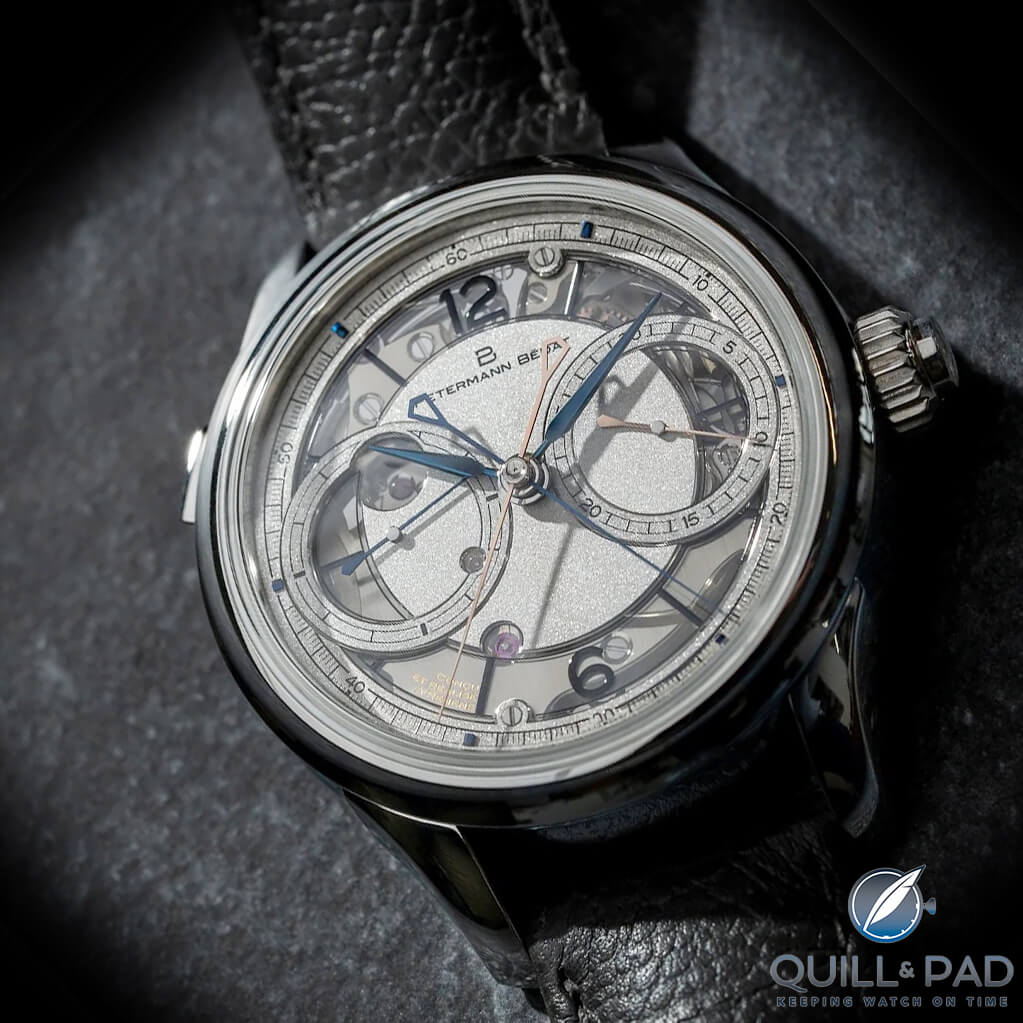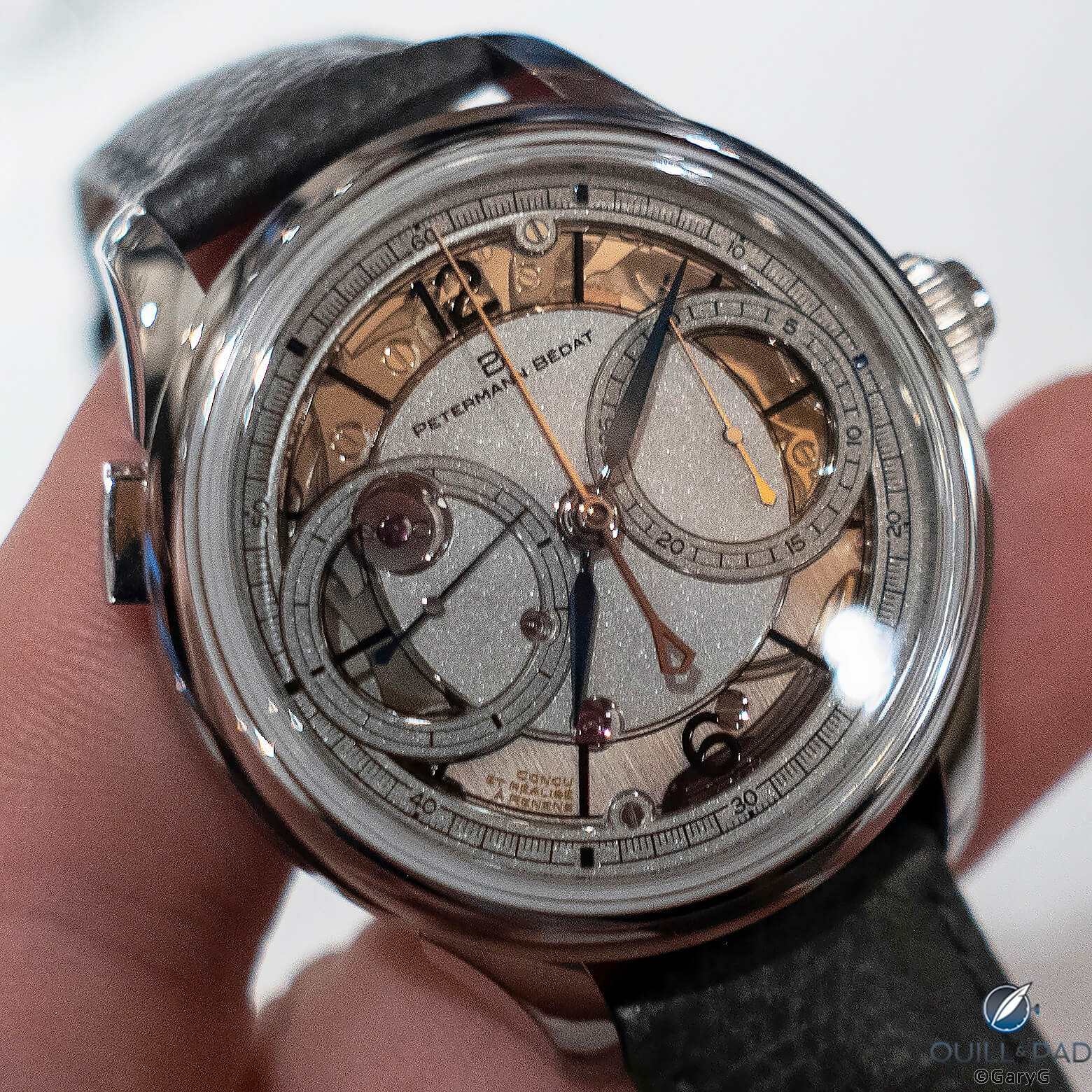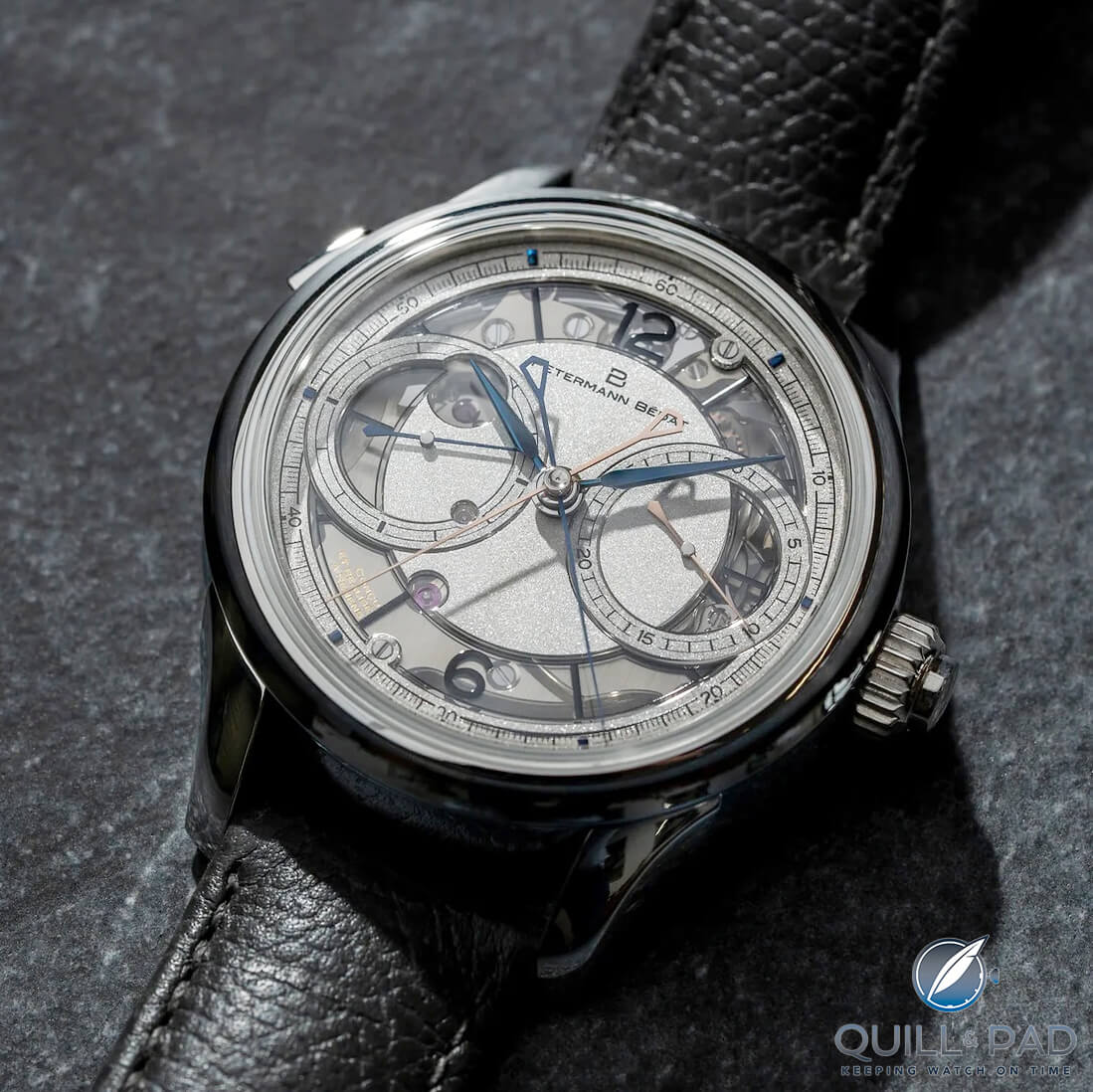Petermann Bédat Reference 2941 Split-Seconds Chronograph: Best Chronograph at the 2023 GPHG
Many say that if you aren’t first, you’re last, and that often rings true. Whether it be in a race in the Olympics or a race to be the first to invent fusion energy, being first often means great things. It isn’t common that people will remember the person that came in second in anything.
I can tell you the first person to break the sound barrier, the first to fly a powered airplane, and the name of the first U.S. president, but it took a Google search to verify who broke the sound barrier second (civilian pilot Herbert Hoover) and made the second working airplane (unsurprisingly, it was also the Wright brothers).
Only now can I remember that John Adams was the second U.S. president thanks to Lin-Manuel Miranda and his hit Broadway show, Hamilton.
But being first isn’t always a guarantee of lasting popularity and fame either. The once ubiquitous VHS tape was a later follower to the original, higher quality Sony Betamax, but cost, recording length, and a missed opportunity to partner with Hollywood for home video rentals meant Betamax lost out and was forgotten as anything other than a “failure.”
An even more widely known product, Oreo cookies, was not at all the first chocolate sandwich cookie with a cream filling. Oreo was an imitation of the four-year-old cookie named Hydrox, but it was able to eclipse the original in popularity resulting in the actual first chocolate sandwich cookie in America being perceived as the knock-off, and it never recovered.
Beyond market success or failure, sometimes being first is truly dangerous. The first person to break the sound barrier and the first to invent the airplane were not the first to try, and some paid with their lives. It can be risky to be the first, something I am certain Neil Armstrong and Buzz Aldrin would have told you after writing their last will and testament before taking off on Apollo 11.
In reality, almost every single “first” we talk about was not a first attempt, or even the first version of some invention. The fact that iteration is a huge part of the success involved in achieving any first is sometimes lost on the wider public because we don’t see the possibly hundreds of attempts before success.
We only tend to see or hear about the final step and think that was where it began. Success takes time, practice, and many steps to achieve anything worthwhile, and even that final success is only the beginning of another journey towards bigger accomplishments.

Petermann Bédat Reference 2941 Split-Seconds Chronograph
That brings me to the young independent brand Petermann Bédat which just launched its second timepiece, the Reference 2941 Split-Seconds Chronograph, after its successful first model, the 1967 Deadbeat Seconds. That release was actually the second version of the same model as well, with a first iteration debuting six months earlier and receiving some pushback necessitating a bit of a redesign.
The new Reference 2941 Split-Seconds Chronograph is therefore, technically, the brand’s third release and it shows all the hallmarks of building on the success and lessons learned from each previous release.

Petermann Bédat Ref. 2941 Rattrapante
And it well deservingly took the prize for Best Chronograph at the 2023 GPHG.
————————————————————————————————————–
—————————————————————————————————–
Petermann Bédat Reference 2941 Split-Seconds Chronograph
Launched in March 2023, the 2941 Split-Seconds Chronograph doubles down on the finishing and mechanical complexity found in the brand’s debut model. Making a split-seconds chronograph is not a simple extension of the previous model, even with its dead-beat second mechanism, this model required a ground up development for the caliber 202.
Yet to maintain cohesion across models, the Split-Seconds Chronograph follows the same design codes established by designer Barth Nussbaumer for the Dead-Beat Seconds, including the partial sapphire dial and monochromatic finish.
The mechanism is visible through a sapphire ring around the platinum dial, though not enough to truly grasp what is going on. It is more of a sneak peek into the split-second function while the rest of the chronograph mechanism is seen on the rear.

Petermann Bédat Reference 2941 Split-Seconds Chronograph
Two satin sub dials flank the central hands, at 3 o’clock you find an instantaneous 30-minute counter and at 9 o’clock the running seconds dial. Around the edge of the dial is the minutes/chronograph seconds track displaying numerals on the tens and easy-to-understand segmented hash marks.
Moving inward, the hours are kept simple with only the 12 and the 6 being marked with numerals while the rest consists of simple hash marks, all printed directly on the sapphire ring.
To keep the visual language distinct and information separated, the basic time telling hands are all in polished and blued steel while the chronograph hands are in gold, save the black rattrapante seconds hand appearing from beneath.
This contrast is small but provides some separation between the two functions even though the dial harmonizes all these elements together. No one would argue that the arrangement makes the 2941 Split-Seconds Chronograph the most legible chronograph in the world, but it manages to open up the dial more.
The chronograph is operated by two buttons, one in the crown like a typical monopusher chronograph, and a second at 10 o’clock for the split-seconds function.
—————————————————————————————————–
—————————————————————————————————–
Movement is where it’s at
I would argue that this second button takes the chronograph out of the monopusher category, at least in spirit, but the simplicity of having only two buttons for a split-seconds chronograph keeps it as visually clean and simple as mechanically possible.

Movement of the Petermann Bédat Reference 2941 Split-Seconds Chronograph
Where the 2941 Split-Seconds Chronograph really proves itself is its awesome mechanics. A glimpse at the partial sapphire dial invites you to be curious before you flip the watch over to discover what it is hiding.
No fewer than 339 components make up the caliber 202, but not all of them are on display like a typical split-second chronograph. Unlike the towering cityscapes of other popular movements, the split-seconds mechanism was moved to the dial side of the watch and is mostly hidden, all with the intention of allowing clear access to the basic chronograph mechanism and its extraordinary finishing.
Visual access was always the goal, even though many people like to watch the movement in action; Petermann and Bédat agreed that highlighting the extensive finishing on the custom components was more important.
Finishing is, understandably, one of the main selling points for a watch of this caliber (and price) as it has to compete against several excellent split-second chronographs on the market, many also featuring top-notch hand-finishing.

Column wheel of the Petermann Bédat Reference 2941 Split-Seconds Chronograph
The design of the components, carried from the original Dead-Beat Seconds model, includes a variety of aesthetic choices, including hooked devil tails on levers and swooping flourishes adding dynamic movement to the mechanism.
Everything is finished with perfect black polishing, chamfered edges, and perfectly aligned Geneva stripes with ne’er a flaw, something that takes an extreme amount of effort for a movement with this many arcs and corners.
In fact, the hooked devil tails are an exercise in showmanship, demonstrating the level of finishing they are capable of more than their specific design ideologies.
—————————————————————————————————–
—————————————————————————————————–
Taking it to another level
The same level of finishing is present on the dial side even though most is hidden, but there is enough on display to entice you to look further. Curiously, when you flip over the watch you find that the movement is upside down from how it would normally be.
Typically, the way a person would flip over a watch is around the vertical axis, rolling it over in their hands while holding on to the strap.
In the case of the 2941 Split-Seconds Chronograph, the correct way to flip it over is from top to bottom, similar to turning a page on a legal pad. This is only obvious because the engraved text on the movement is oriented in this direction, but once you notice this it becomes clear that it does feel upside down.
Balance wheels are often at the bottom of a movement and in this orientation, it is at the top, even though when looking at the movement with the text reading properly, the balance is once again on the bottom.

Petermann Bédat Reference 2941 Split-Seconds Chronograph caseband
This is one weird quirk that doesn’t affect anything yet stood out to me immediately upon my first glance, something felt off. It’s an odd detail that makes the 2941 Split-Seconds Chronograph different from most watches out there in just one more way, and that feels perfectly aligned with what they have tried to accomplish.
This watch is something wild and unique and yet fairly subdued for the effort put in.
It represents an amazing new entry into the world of split-seconds chronographs from a small independent brand and it appears poised to take the watch world a bit by storm this year. I can easily see this piece picking up a prize at this year’s GPHG, and the model leading to a successful run of developments from Petermann Bédat.
I urge you to explore the Petermann Bédat Reference 2941 Split-Seconds Chronograph as it deserves a closer look and time spent discovering everything it has to offer inside and out.
And while you explore, I’ll try my best to break this down!
- Wowza Factor * 9.6 From the incredible movement to the understated design, this piece packs a hefty wowza factor!
- Late Night Lust Appeal * 96 » 941.438m/s2 Spending hours gazing into the caliber 202 is enough to keep you lusting after the 2941 until sunrise!
- M.G.R. * 70.2 The quality of the finishing and the details of the split-seconds chrono mechanism are enough to make this one of the geekiest movements in a while!
- Added-Functionitis * Mild A chronograph is a very serious added function for a watch, but it usually only counts as one, even with the rattrapante and instantaneous minute counter. Still, I’d recommend using some children’s strength Gotta-HAVE-That cream to manage the horological swelling!
- Ouch Outline * 11.4 Pinching a nerve in your hip?! Chalk it up to getting older, but I found that pinching a nerve on the interior of your hip joint is a strange yet uncomfortable experience. Still, I would gladly live with that pain for weeks if it meant I was able to get the 2941 Split-Seconds Chronograph on my wrist!
- Mermaid Moment * That top notch finishing! Being able to dive into the extensive finishing is what makes you fall mad with desire, enough to start asking friends to be groomsmen!
- Awesome Total * 813 First, start with the alloy of the platinum in the case (950) and subtract the number of components in the movement (339), then add back in the caliber number (202) to end up with a bold new awesome total!
For more information, please visit www.petermann-bedat.ch/à-propos-1.
Quick Facts Petermann Bédat Reference 2941 Split-Seconds Chronograph
Case: 38.6 x 13.7 mm, platinum
Movement: manually wound caliber 202, 42-hour power reserve, 18,000 vph/2.5Hz
Functions: Hours, minutes, seconds, split seconds chronograph with instantaneous 30-minute counter
Limitation: 10 pieces (sold out)
Price: CHF 243,000
* This post was first published 15 May 2023 at Petermann Bédat Reference 2941 Split-Seconds Chronograph: Second Time Around Never Looked Better
You might also enjoy:
Petermann Bédat Seconde Morte: Dead Seconds, Independently (Video)
De Bethune DB Eight: The Ultimate in Chronograph Refinement!
Here’s Why: The Chronograph Is The New Tourbillon
Singer Reimagined Divetrack: The World’s Best Mechanical Divers’ Watch – Bar None!






Leave a Reply
Want to join the discussion?Feel free to contribute!